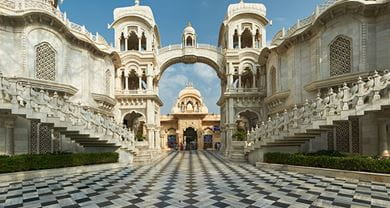- Trending:
- Pope Leo Xiv
- |
- Israel
- |
- Trump
- |
- Social Justice
- |
- Peace
- |
- Love

RELIGION LIBRARY
ISKCON (Hare Krishna)
Schisms and Sects
Like most new religious movements, ISKCON experienced a variety of schisms, most notably after the death of its founder, A.C. Bhaktivedanta Swami Prabhupada. In the thirty years since Bhaktivedanta's death, ISKCON has grown in size to number approximately 50,000 people in the United States, and according to the movement's own estimates, one million worldwide. However, a majority of Bhaktivedanta's earliest disciples left the movement, many forming or joining alternative sects that compete with ISKCON proper. It is therefore appropriate to speak of a wider Krishna Consciousness movement outside the institution of ISKCON. Many adherents of Krishna Consciousness outside of ISKCON simply call themselves Hare Krishnas or Vaishnavas.
The first official schism within ISKCON occurred in 1982, when a debate arose within ISKCON over the appropriateness of seeking religious guidance from other members of the Gaudiya Vaishnava lineage outside ISKCON. In particular, several prominent members of the movement, as well as the Governing Body Commission (GBC) itself, had sought the aid of Shridara Maharaj Goswami, a "godbrother" of ISKCON founder Bhaktivedanta, beginning just a year after Bhaktivedanta's passing.
The wider Hindu tradition recognizes a quasi-familial relationship between students of the same guru, and since Shridara had taken initiation and training from Bhaktivedanta's guru, Bhaktisiddhanta Sarasvati, many ISKCON members looked to him as a valid spiritual authority. Recognizing the possibilities of multiple conflicting religious authorities, in 1984 the GBC declared that ISKCON members may not "associate" with Shridara or any other Gaudiya Vaishnava leader outside the movement, and explicitly forbade accessing material produced by outside teachers. Approximately 10 percent of ISKCON's full-time initiated membership left the movement in response, joining Shridara's Gaudiya Math organization instead. In most cases, such former ISKCON members retained their self-understanding as Hare Krishnas, and their affection and dedication to ISKCON founder Prabhupada, but did so from within the confines of a different institution. A similar pattern followed in the 1990s when a contingent of at least three hundred devotees left ISKCON to begin following another Gaudiya guru, Narayana Maharaja.
Though defections to Shridara led to ISKCON's first schism, it was not the largest such split. Far more intensive and long-lasting has been the "ritvik controversy," which began shortly after Prabhupada's death, but only rose to the forefront of ISKCON consciousness in the 1990s. Shortly before Bhaktivedanta's passing, the elderly founder appointed eleven of his senior disciples as ritviks, a term best translated as officiating priests. As ritviks, these disciples could serve as religious authorities who acted on behalf of their own guru, Swami Prabhupada. Though they could teach and write in their own names, they could initiate only in the name of Prabhupada, and those devotees who took initiation under them officially accepted A.C. Bhaktivedanta Swami as their guru, not the ritvik who officiated at their initiation.
Following Bhaktivedanta's death and under the direction of the GBC, these eleven ritviks transitioned into the role of actual gurus, and began initiating disciples under their own names, taking students who considered them their spiritual masters rather than Bhaktivedanta. They also established what became known as the zonal archarya system wherein each guru managed a geographic region as sole religious and temporal leader. After the termination of the zonal archarya system in the 1980s, another system of multiple independent gurus replaced it.
The ritvik controversy emerged when a significant number of ISKCON devotees rejected the authority of the eleven men to serve as gurus, and instead believed them to be ritviks, capable of preaching and teaching Krishna Consciousness, but serving only as intermediaries to the ultimate guru authority, Bhaktivedanta. Each side of the ritvik controversy was able to offer scriptural, theological, and historical evidence to support its contentions, and though the ISKCON governance rejected ritvikism, a significant number of devotees embraced it.
In the late 1990s, ritvik supporters formed the ISKCON Revival Movement, a group that seeks to replace ISKCON's current guru model with a ritvik-based one. The group has attracted the interest of substantial numbers of ISKCON devotees. According to some recent surveys, about one quarter of ISKCON's full-time adherents and half of its congregational members agree that Prabhupada wanted the appointed ritvik gurus to continue as ritviks after his death. Many devotees who support ritvikism remain within ISKCON, but significant numbers have left the International Society and now practice their Krishna Consciousness at home or in small gatherings of like-minded disciples. The ISKCON Revival Movement currently publishes an alternative magazine, entitled Back to Prabhupada, a name that reveals their attachment to the historical origin of ISKCON, even while rejecting the institution.
Though far fewer in numbers than either the divisions over other Gaudiya gurus or ritvikism, ISKCON has also experienced schisms when its gurus have formed alternative sectarian groups. Most notable of these is the City of God movement formed by Kirtanananda Swami, also known as Bhaktipada (1937-). One of the original eleven gurus named by Bhaktivedanta, Kirtanananda led the largest ISKCON residential center in North America, the rural West Virginia agricultural commune of New Vrindaban. In 1986, Kirtanananda declared that the community would henceforth be called New Vrindaban City of God, which he dedicated to interfaith religious work. Introducing Christian worship and icons into his religious community, Kirtanananda attempted to fuse Vaishnava and Christian practices. ISKCON expelled the swami and his followers, and his movement subsequently collapsed under accusations of racketeering, conspiracy to murder, and child molestation. Kirtanananda's movement still exists, though with only a handful of members in India and Pakistan. New Vrindaban reverted to normative ISKCON worship and theology in 1994 and was formally re-admitted to ISKCON in 1998.
Study Questions:
1. Describe the relationship between Bhaktivedanta's death and the schisms of ISKCON.
2. Who was Goswami, and how did he contribute to ISCKON's first official schism?
3. What was the ritvik controversy about?
4. What sect did Kirtanananda Swami create? Why did it fail?










